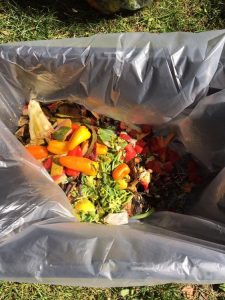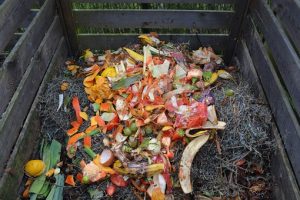Did you know that more than 38 million tons of food waste was generated in the U.S. in 2014? To help address this issue, OSU Extension Cuyahoga County teamed up with two local partners this past summer to launch a Food Waste, Recovery, & Education pilot program at the Tremont Farmers’ Market. OSUE Cuyahoga County, Rust Belt Riders, and Stone Soup Cleveland piloted a community composting program, modeling the efforts of cities such as Washington, .D.C. and New York City. The pilot program aimed to help reduce food waste and divert scraps from landfills while providing education about food insecurity and food recovery systems.
So, how did it work?
 The partners spent 4 weeks at the farmers’ market doing outreach and promotion before beginning 8 weeks of scrap collection. The pilot offered free sunflower planting for children (and adults!) with compost from Rust Belt Riders to help spark community engagement and begin dialogue about food waste in the county.
The partners spent 4 weeks at the farmers’ market doing outreach and promotion before beginning 8 weeks of scrap collection. The pilot offered free sunflower planting for children (and adults!) with compost from Rust Belt Riders to help spark community engagement and begin dialogue about food waste in the county.
Residents who signed up for the free program 8 week were provided one-gallon containers with lids that they could take home and use to collect their compostable food scraps over the course of the week. Residents could bring their scraps to the farmers’ market to be weighed and recorded, helping them gauge their waste production and environmental impact. The containers were emptied into a larger bin that would be later delivered to Rust Belt Riders to be composted.
Over 30 community members actively participated in the Food Waste and Food Recovery pilot project at the Tremont Farmers’ Market. Over 8-weeks, residents were able to drop off their compostable food scraps and engage in food waste education. In just 8 weeks, over 750 pounds of food scraps were diverted from landfills. 88% if participants were surprised by how much food waste they were producing, and 94% of participants stated the program helped them become more conscious about the amount of food waste they produce.
While the program was designed to serve apartment dwellers, almost 30% of participants were homeowners with access to a yard who noted they did not know how to properly compost. Through this pilot, we learned that there may be a significant number of households in Cleveland who are not composting simply because they do not know how. Composting workshops have been set up to serve those participants and other homeowners who are interested.
 As with any pilot project, you set out not really knowing what will happen and inevitably encounter a variety of challenges and valuable lessons. We were pleasantly surprised by the level of community engagement and support, but we did not consider any potential drawbacks such as odors. We quickly learned that we needed to ask program participants to place their containers in the fridge or freezer to slow decomposition and eliminate any unpleasant smells. A few very ripe containers caused some of our market neighbors to be a bit upset.
As with any pilot project, you set out not really knowing what will happen and inevitably encounter a variety of challenges and valuable lessons. We were pleasantly surprised by the level of community engagement and support, but we did not consider any potential drawbacks such as odors. We quickly learned that we needed to ask program participants to place their containers in the fridge or freezer to slow decomposition and eliminate any unpleasant smells. A few very ripe containers caused some of our market neighbors to be a bit upset.
The pilot was well received by community members and market vendors, being seen as a valuable addition to the farmers’ market, but we did not have any next steps planned. As the pilot ended, program participants were anxious to know what they might do with their scraps. We had created a group of food waste conscious community members, but did not have a long-term solution for them. When we surveyed participants after the pilot ended, 41% said they would participate in fee-based residential compost services in the future. This finding sparked Rust Belt Riders to create a Community Supported Compost Program, where residents can pay for an annual membership that allows them to drop their scraps off at their facility to be composted at any time through the year.
The partners plan to host the program at the Tremont Farmers’ Market again next summer, extending the programming to be offered for a longer duration of 16-20 weeks!
What will you do to reduce your food waste? To learn more about food waste and food recovery systems, contact Amanda Osborne, County Extension Educator, Cuyahoga County & Western Reserve EERA.


 What can we do? A compost pile is an option if you own your home and have a small space available in your yard. Backyard composting is common in United States, but is best suited for those who own a home with a yard. The renter and apartment dwellers without a yard face the greatest challenge. According to the
What can we do? A compost pile is an option if you own your home and have a small space available in your yard. Backyard composting is common in United States, but is best suited for those who own a home with a yard. The renter and apartment dwellers without a yard face the greatest challenge. According to the 
 The economic effects of food waste are just as startling. Americans throw away the equivalent of $165 billion worth of food each year. In addition to food waste occurring at the consumer level, 10% of the total food supply at the retail level enters the solid waste stream. The USDA estimates that supermarkets lose $15 billion annually in unsold fruits and vegetables alone, in addition to the baked goods, meat, seafood, and ready-made foods that go unsold. These items can easily be recovered from the waste stream by donating them to local food banks and food pantries, and retailers can receive tax benefits for doing so.
The economic effects of food waste are just as startling. Americans throw away the equivalent of $165 billion worth of food each year. In addition to food waste occurring at the consumer level, 10% of the total food supply at the retail level enters the solid waste stream. The USDA estimates that supermarkets lose $15 billion annually in unsold fruits and vegetables alone, in addition to the baked goods, meat, seafood, and ready-made foods that go unsold. These items can easily be recovered from the waste stream by donating them to local food banks and food pantries, and retailers can receive tax benefits for doing so.